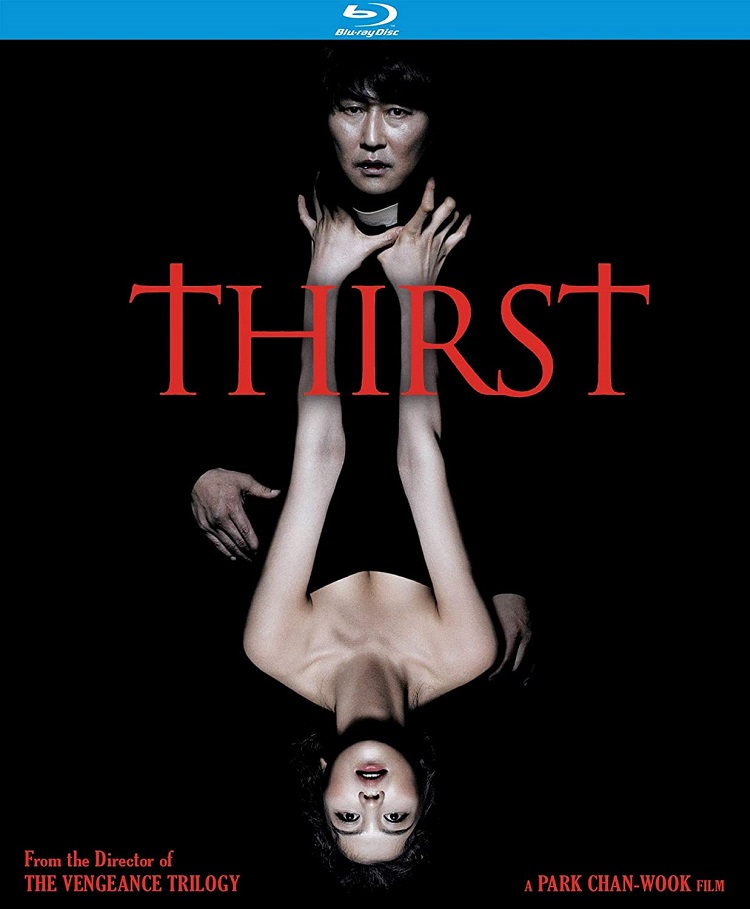
Written by Mule
Thirst (2009) directed by Chan-wook Park is something as oddly inspired as a Korean vampire movie loosely based on Zola’s Thérèse Raquin. Kang-ho Song plays the priest Sang-hyeon. In a misguided attempt to help cure a wasting disease called the Emmanuel Virus, the priest offers himself up to a medical experiment that involves letting himself get infected and then treated. It turns out that one of the procedures actually does cure him, but it leaves him with a strange and disturbing side effect – a thirst for blood. As long as he keeps drinking the ruby-red he’s fine. The second he stops the virus is back in full effect. Sang-hyeon is treated as cross between a medical miracle and a saint, which is really ironic considering he keep his health only by drinking the blood of one of the coma patients in his care.
Sang-hyeon’s self-sacrificing and self-effacing attitude is already starting to show some cracks by the time he gets reacquainted with the orphan Tae-ju (Ok-bin Kim). Tae-ju is living in a domestic arrangement frighteningly close to slavery where Lady Ra (Hae-suk Kim), who has taken her in as a young girl, is using her as a kind of dogs-body while her son Kang-woo (Shin Ha-gyun) who is, to put it politely, a bit simple, is her husband. Under the domestic arrangement lurks some rather ugly sexual frustrations and hunger for freedom that has Tae-ju taking to the streets at night, running barefoot through darkened alleys.
The moral decline of the priest is coupled with Tae-ju’s longing for freedom and it takes a carnal turn quite quickly, which results in the two of them murdering Kang-woo during a nightly fishing expedition after Tae-ju has convinced the priest that her husband is abusing her. Kang-woo’s ghost hangs around, though, in a very tangible and terrifying way and that’s where the most obvious connection to Zola’s novel shines through. Lady Ra drinks herself into a fit after her son’s death and becomes paralyzed. She is cared for by Tae-ju and Sang-hyeon. When the priest finds out that he has committed murder under false pretenses he grants Tae-ju her wish when she asks him to kill her rather than her having to live with the guilt – and the ghost. He can’t stand losing her, though, and brings her back with his own blood, feeding her both the disease and the vampirism in one go.
This is a violent, visceral, gory, deeply carnal and deeply philosophical vampire movie, if you can picture such a thing. It is beautifully rendered too, and everything from the weekly majong games at Lady Ra’s to the straggling camp of believers that pray for a laying on of hands from the martyr-priest-vampire is thought-provoking as well as visually pleasing.
Sang-hyeon embodies the moral struggle of becoming a vampire, but Tae-ju revels in it. Once the priest turns her she becomes as vicious and deadly as any predator and shows no hesitation killing and feeding on the living. It is a juxtaposition that eventually provides the movies final climax, an ending that is nothing less than total destruction, which oddly enough is a kind of redemption as well.
It is a joy to find a movie in this genre that has both depth and substance and doesn’t fall into the trap of making its protagonists shallow eye-candy. There are so many themes involving sin and redemption, temptation and retribution and death and destruction that it is a treat to watch. The special effects are unobtrusive and fully integrated into the action and the actors are playing it with all the depth and pathos that it deserves. This is, hands-down, one of the best vampire movies I have ever had the pleasure to watch, and that’s saying something.